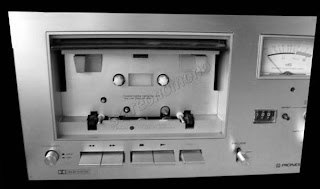Front-Access
2-Motor Solenoid Operated Stereo Cssette Deck with Dolby NR, peak level
Indicator, Ferrichrome/Chrome/Standard Biass and EQ, Memory Stop and Other
Features for better Performance.Features
Pioneer
exclusive front loading design
Twin-link
design improves tape performance
Two-motor,
high performance drive system
Soft-touch
solenoid controls
Chage tapes
without changing mode
Ferrichrome/Chrome/Standard
EQ and bias
Wide range
three-stage preamplifier
Less noise
from FM recording
Input
selector switch
Memory stop
and tape ednd indicator.
Pioneer has
incorporated all the latest innovations in cassette deck design into one
reasonably-priced, high-performance package that is sure to meet your every
need. In many cases our engineers have throughly re-designed a particular
feature to extend a its benefis under conditions that match actual use. A good
example is the front-loading, front-access design itself. An ingeniously
engineered, easy-to-handle tape compartment opens up the full potential of
cassette tapes by increasing convenience without sacrificing quality
performance. Your tapes are positioned vertically, held securely at all times
by a twin-link mechanism. You can easily observe tape movement and direction,
and even read tape labels. Changing tapes is literally a "snap". The
2-motor drive system in the Pioneer CT-F 8282 also makes a lot of sense and
saves a lot of wear and tear. A cspecial DC high-torque motor provides
super-stable tape transport in Play and Record modes, while another miniature
powerhouse delivers fast rewind and fast-forward operation. Special electronics
and greatly improved convenience features round out the CT-F 8282, from
Pioneer.
Adds new
Dimension to Audio Enjoyment
Fast and
easy front panel operation is achieved through carefully apportioned control
layout and Pioneers's original vertical cassette transport system. Simple stand
up cassette loading makes handling effortless.
High
Reliability 2-Motor Transport
Tape motion
during record and playback is regulated by a superbly stable DC servo
controlled motor, while a high torque mechanical governor equipped motor drives
fast forward and rewind. Precision design and finishing of the capstan, belt,
large size flywheel and tape take up mechanism assure outstanding performance
in terms of wow and flutter and stability.
Select
Transport Modes Directly
Direct
chaange system allows any mode (record, play, fast forward, rewind) to be
selected without alternating with the stop switch. Operating convenience
becomes additionally increased, while tape is protected from undue stress.
Reduced Tape
Noise with Built-in Dolby System
Without
adversely affecting the sound quality of the program source, the built-in Dolby
system can significantly reduce bothersome tape hiss noise (by up to
approximately 10 dB at high frequencies). Wide dynamic range, excellent S/N
ratio recording and plauback can be fully enjoyed.
3-stage
Direct Coupled Head Amplifier
Equalization
and microphone amplifiers are comprised of 3-stage direct coupled circuitry to
provide excellent phase characteristics. Application of effective negative
feedback up to ultra high frequencies assures stable high frequency response
and a dynamic range exceeding 40 dB of the base level.
Tough and
Durable Ferrite Soild head
Ferrite
solid composing the record/playback head resists abrasion and features long
durability, superior high frequency response and head touch, in addition to
minimized problems of dirt adhesion and magnetization noise.
Independent
Bias and Equalization Selection
Nearly all
types of tape can be employed, including chrome, low noise, ferrichrome and
standard, by providing separate settings for bias and equalization. The special
qualities of each type become fully experienced. A new equalization design
(3180 +70 µs) is included and the electronic switching circuit eliminates
switching noise.
Large Level
Meters and LED Peak Indicator
Large size,
easy to see level meters are mounted on the front panel together with a light
emitting diode (LED) peak indicator which advises of instantaneous over levels.
Reliable signal monitoring can be performed, permitting low distortion
recording of wide dynamic range program sources.
Quality
Convenience Features
Memorey Stop
Switch - employ during recording or playback by simply pressing the memory
button and resetting the counter at the beginning of the desired passage. When
the passage is completed, press the rewind lever. The tape will then rewind to
the selected point and stop automatically.
Input
Selector Switch - selects between Line (pin jack) and DIN jack input signals.
By setting to DIN when recording with microphones, microphone input level can
be attenuated by 10 dB.
Specifications
Systems: Compact cassette, 2-channel stereo
Motors:
1 x
Electronically-controlled DC motor (built0in generator);
1 x Dc
torque motor (4,8 cm/s speed drive)
Heads:
1 x Ferrite
Solid recording/playback
1 x ferrite
erasing
Operation: Solenoid drive, direct switchable and time
play presettable
Fast Winding
Time: Approx. 65 sec. (C-60 tape)
Wow and
Flutter: No more than 0,07% (WRMS)
Frequency
Response:
Standard, LH
Tapes : 20 - 16,000 Hz (30 - 13,000 Hz
±3 dB)
Chromium
Dioxide Tape : 20 - 17,000 Hz (30 - 15,000 Hz
+_3 dB)
Ferri-chrome
Tape : 20 - 17,000 Hz (30 - 15,000 Hz ±3 dB)
Signal-to-Noise
Ratio (Dolby OFF/ON): More than 53 dB/63
dB
Harmonic
Distortion: No more than 1,5% (0 dB)
Inputs
(Reference Level/Max. Allowable Input/Impedance):
Mic x
2 : 0,2 mV/100 mV/50 k Ω
Line x
2 : 60 mV/25 mV/100 k Ω
DIN
(Rec/Pb) x 1 : Input & Output, 5,5 mV/3,6 mV/8,7 k Ω
Outputs
(Reference level/Max level/ Load Impedance):
Line x
2 : 450 mV/660 mV/50 k Ω
Headphones
x 1 : 60 mV/98 mV/8 Ω
DIN
(Rec/Pb) x 1 : 450 mV/660 mV/50 k Ω
Semiconductors
Amplifier
Section: 60 Transistors; 40 Diodes;
4 Zener Diodes; 4 FETs; 2 LEDs; 1 Hole elementary
Motor
Coontrol Section: 3 Transistors; 1
Diodes
Subfunctions:
Dolby System
(ON/OFF) with indicator lamp
Tape
Selector (STD/CrO₂/FeCr) with CrO₂ indicator lamp and manual tape selector of
independently Bias/EQ (Ferri-chrome tape available)
Cassette
compartment illumination
Memory stop
mechanism (ON/OFF) with indicator lamp
Recording
peak level indicator (lightable level 5 dB)
AC outlet
(unswitched)
Powe
Requirements: AC 120 , 220, 240 V 50/60 Hz
Power
Consumption: 54 watts
Dimensions
(W x H x D): 452 x 193 x 348 mm
(17-3/4" x 7-5/8" x 13-3/4"
Weight: 12,5 kg
(27,6 lbs)






Good deck vintage 70s!!
RispondiElimina